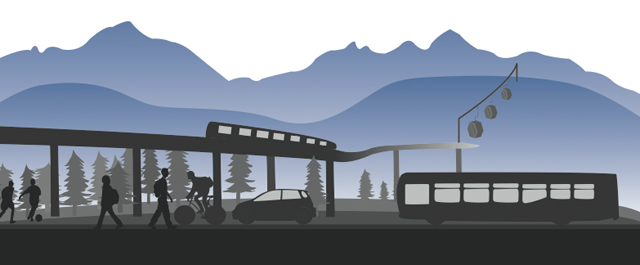Burnaby Mountain Gondola Business Case
Burnaby Mountain Gondola Business Case

The business case and alternatives assessments for the Burnaby Mountain Gondola Project are now available online. When I last wrote about the project/study, TransLink was in Phase 2 (public consultation) of the project. The business case and alternatives assessment evaluate the feasibility of the project and examine if there is a good business case for installing and running a gondola from Production Way-University station versus solely running buses up and down Burnaby Mountain.
No plans yet for Phase 3 (implementation) of the gondola
Although the business case for the gondola is favourable as far as benefits to commuters and the region (see section directly below), the gondola is not included in TransLink’s current strategic transportation plan. Currently, TransLink’s plan has approved funding for the Evergreen Line, transit service improvements across the region and increases in funding for road and cycling infrastructure (see Moving Forward supplemental plan). There is not approved funding at this time for the Burnaby Gondola Project. According to the business case, the gondola would cost $12 million greater than continuing to use buses to serve SFU on Burnaby Mountain over the next 25 years.
Key findings of the business plan in terms of implementing a gondola on Burnaby Mountain
- Up to 1.6 million annual hours of travel time savings for current transit customers (half the travel time of taking the #145);
- Reductions of up to $4.5 million per year in auto operating costs for commuters switching to transit, plus as much as $3.4 million in reduced collision costs;
- A reduction of at least 6,900 tonnes in GHG emissions and reduced noise from reduced use;
- Overall social and financial benefits are 3.6 times greater than costs;
- Improved performance and service reliability in winter conditions.
The future of the gondola
The concept of running a gondola up Burnaby Mountain to serve SFU and the surrounding community will continue to be a candidate for inclusion in future strategic transportation plans. Should the project proceed in the future, TransLink will look at closing the financial gap of the project as well as identifying other funding to possibly relocate some of the existing bus services on Burnaby Mountain to other parts of Metro Vancouver that need them. Like the consultation that went on in 2011 on the project, if the gondola is again proposed for a future strategic transportation plan, a similar public consultation period will follow.






I hope this is revisited for inclusion in an upcoming capital plan sooner rather than later. It seems like an idea that just makes too much sense to let die.
I’m rather intrigued by the auto cost savings calculation of 4.5 million for vehicle operating costs and 3.4 million for collisions. That implies that a car owner spends almost as much for collisions as they do for gas, etc. Perhaps “collisions” is a synonym for insurance? If not, that seems like a major cost of private transportation that’s been flying below the radar…
Sorry, I have trouble with this “it will cost $12 million more over 25 years.” Please explain the difference between such a prediction, and total fiction.
One thing that doesn’t appear to be accounted for in the business case is the cost of diesel fuel over the next 25 years.
I recognize that it is difficult to predict future fuel costs with any sort of accuracy, but it appears that the cost of a bus service hour remains unchanged throughout the 25 year project life. Transit bus fuel efficiency certainly hasn’t improved over the past 25 years (in fact modern buses use more fuel than their older counterparts), and fuel costs have dramatically increased. One could expect that there would be at least some trend in this regard in to the future.
Note that I am excluding hybrid buses with the fuel consumption comment above as they have proven to not work particularly well on the SFU routes.
I thought that this plan is not goina be available.